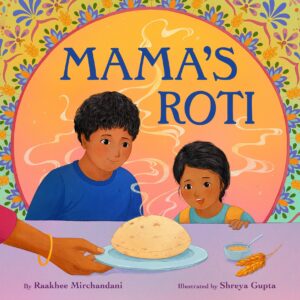Reviewed by Paige Pagan
Review Source: Teaching for Change
Book Author: Raakhee Mirchandani
Mama’s Roti is a moving picture book for young elementary children about the ways in which food connects us to our home country, culture, and community and an ode to the farmers who grow the food through harsh conditions and discrimination.
A girl ruminates on what roti means to her. On the micro level, it’s Mama singing old songs while rolling the dough, it’s her brother laughing while poking the phulka, it’s Nani’s technique passed down, a snack in the car, lunch with friends, and a Sunday trip to the grocery store. On the macro level, it’s the Kisan of Punjab laboring with love over the fields that stretch on for miles under the hot sun, praying for rains that will make the feathery grains flourish.
Roti isn’t just about the girl’s past and where she came from, but also about her future in a new country and how it will continue to sustain her and other families during bad times and good. Roti is change, standing together in protest, whether in India or overseas, to fight for farmers rights — proper protection from the elements and fair wages — who have long been neglected despite the fact that their crops remain a reliable life source. Roti is this girl’s story, as well as that of countless others.
Mama’s Roti is particularly notable for its focus on Punjabi/Haryana farmers. While the COVID-19 pandemic was memorable for many reasons, one of those for me was the large-scale protests from 2020-2021 where farmers in Punjab organized and rose as a major political and social force, asking for basic legal rights. Amongst the slew of social media advocacy at the time, friends and family made “Protect Sikh Farmers!” posts, afraid it was all we could do to show our support from across the globe as we watched that crisis go unacknowledged in the shadow of the virus. As Mirchandani mentions in her author note, after over a year of consistent protests, India finally changed its laws, but many farmers died before being granted these rights and protections.
Sikh farms are the largest supplier of crops in all of India and dominate Indian exports, yet the labors of Punjabi/Haryana farmers have long been ignored. I appreciate Mirchandani’s reminder to readers, regardless of background, that if you’ve ever enjoyed a warm, fluffy roti, you should also think of the Punjabi/Haryana farmers who toiled for you to have it.
There’s a clear gender binary introduced in the narrative. In the illustrations, readers see women dominating the kitchen, accompanied by sentiments like roti is “a mother’s hand that mixes the atta” (7). We see the protagonist’s grandmother and mother kneading and rolling the dough, teaching the girl how to do the same, but not her brother. While the girl’s brother appears in the kitchen, it’s only to wait for the roti to be finished without him showing any interest in how it’s made even though he’s visibly the older sibling.
Men are mostly shown as the farmers alongside the women. The only illustration readers see of a man and boy assisting in the kitchen is on the penultimate page as spot art. Though culturally food preparation is an opportunity for women and girls across generations to congregate, serving as a means of connection, it’s important to ensure that domestic chores like cooking aren’t relegated to women.
Paige Pagan is a Social Justice Books program specialist at Teaching for Change.
Find more books on this topic on our Food as Culture and South Asian booklists.

Mama's Roti by Raakhee Mirchandani
on November 25, 2025
Genres: Asian American and Native Hawaiian/Pacific Islander, Food, Immigration and Emigration, South Asian
Pages: 40
Reading Level: Early Childhood, Grade K
ISBN: 9780316339469
Review Source: Teaching for Change
Also by this author: Hair Twins
Publisher's Synopsis: A powerful story about the life-giving force of roti, a round Indian flatbread, and where it comes from, the people who grow it, and what it symbolizes within two families, inspired by the farmers' protests in India.
A roti isn't just a roti. It's a day in the hot sun tending to the wheat fields. It's little grains of truth about where we come from. It's a snack in the car for the perfect road trip lunch. It's hundreds of hands over thousands of years, kneading together our story.
Told through alternating perspectives of a family in America and a family in India, this powerful cross-continental, intergenerational story proves that something as small as a grain of wheat can create a powerful sense of community.


Leave a Reply